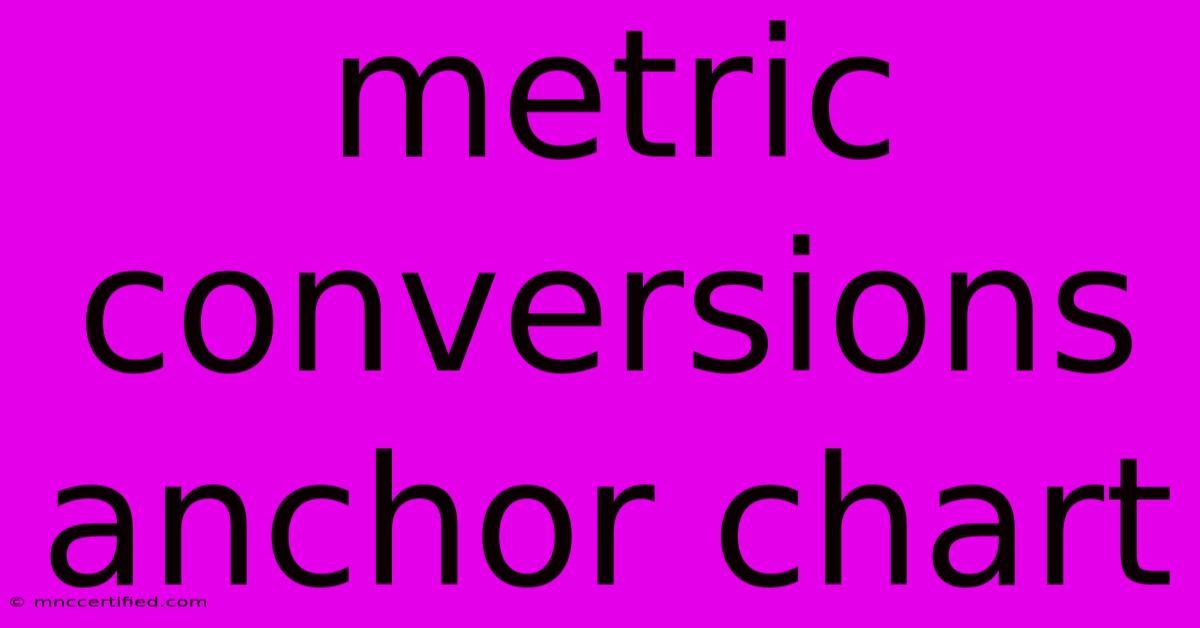Metric Conversions Anchor Chart

Table of Contents
Metric Conversions Anchor Chart: Your Ultimate Guide to Mastering the System
Metric conversions can be tricky, but they don't have to be! A well-designed metric conversions anchor chart is your secret weapon for mastering this essential system. This comprehensive guide will walk you through creating and using the perfect anchor chart for effortless metric conversions, covering everything from basic units to advanced applications. We'll also explore effective strategies for incorporating your anchor chart into your learning process.
Understanding the Metric System: A Foundation for Conversions
Before diving into creating our anchor chart, let's briefly review the foundations of the metric system. The International System of Units (SI), commonly known as the metric system, is a decimal system, meaning it's based on powers of 10. This makes conversions incredibly straightforward compared to the imperial system. The key prefixes are crucial for understanding the relationships between units:
- Kilo (k): 1000 (10³)
- Hecto (h): 100 (10²)
- Deka (da): 10 (10¹)
- Base Unit (e.g., meter, liter, gram): 1 (10⁰)
- Deci (d): 0.1 (10⁻¹)
- Centi (c): 0.01 (10⁻²)
- Milli (m): 0.001 (10⁻³)
Designing Your Metric Conversions Anchor Chart: A Step-by-Step Guide
A great anchor chart is visually appealing and easy to understand. Here's how to create yours:
1. Choose Your Key Units:
Focus on the most commonly used units for length, mass, and volume:
- Length: Kilometer (km), meter (m), centimeter (cm), millimeter (mm)
- Mass: Kilogram (kg), gram (g), milligram (mg)
- Volume: Kiloliter (kL), liter (L), milliliter (mL)
2. Visual Representation:
Several visual approaches can effectively represent metric conversions:
- Chart: A simple table showing the relationships between units is a good starting point. You can arrange units from largest to smallest (kilometers to millimeters) for easy visualization.
- Diagram: A visual diagram like a staircase or ladder can visually depict the progression of units and the power of 10 relationships.
- Conversion Factors: Clearly display the conversion factors (e.g., 1 km = 1000 m).
3. Color-Coding and Labeling:
Use color-coding to distinguish between different units (e.g., length in blue, mass in red, volume in green). Clear, concise labels are essential for easy understanding.
4. Incorporating Examples:
Include simple conversion examples to illustrate the practical application of the chart. For instance, show how to convert 2.5 kilometers to meters (2.5 km * 1000 m/km = 2500 m).
5. Adding Mnemonics:
Consider adding a simple mnemonic device to help remember the order of prefixes. "King Henry Died By Drinking Chocolate Milk" is a popular one, representing Kilo, Hecto, Deka, Base, Deci, Centi, Milli.
Using Your Metric Conversions Anchor Chart Effectively
Once your anchor chart is complete, use it consistently:
- Post it in a visible location: Place it near your study area or workspace for easy access.
- Refer to it frequently: Don't rely on memorization alone; use the chart as a reference tool.
- Practice regularly: Use the chart to practice conversions regularly. Start with simple conversions and gradually move to more complex ones.
- Create practice problems: Challenge yourself with various conversion scenarios to reinforce your understanding.
Beyond the Basics: Advanced Applications of Your Anchor Chart
Your anchor chart isn't limited to basic conversions. You can expand it to include:
- Area and Volume Conversions: Show how to convert square meters to square kilometers or cubic centimeters to cubic meters.
- Temperature Conversions: Include a section on converting Celsius to Fahrenheit and vice versa (though this isn't strictly part of the metric system).
- Scientific Notation: Integrate the use of scientific notation for expressing very large or very small numbers.
By following these steps, you'll create a powerful tool for mastering metric conversions. Remember, consistent use and practice are key to achieving proficiency. Your metric conversions anchor chart will become an invaluable resource throughout your studies and beyond.

Thank you for visiting our website wich cover about Metric Conversions Anchor Chart. We hope the information provided has been useful to you. Feel free to contact us if you have any questions or need further assistance. See you next time and dont miss to bookmark.
Featured Posts
-
Kendrick Lamar Drops Gnx Album
Nov 23, 2024
-
F1 Nears Expanded Grid For Gm
Nov 23, 2024
-
Join Instagram Live Anonymously
Nov 23, 2024
-
Aaa Car Insurance Vs State Farm
Nov 23, 2024
-
Ringworm Warning Surge In Young Men
Nov 23, 2024